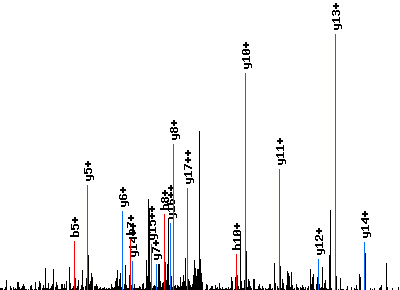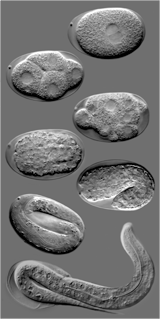Systems biology

| people involved | selected publications |
Our group is also interested in studying the model organism C. elegans at the systems level. One of our particular strengths is proteomics, which we use in order to get quantitative information about the final and most relevant output of gene expression – protein levels.
We are part of the Center for Model Organism Proteomes (C-MOP) initiative, which applies proteomics in order to better understand common model organisms, including Drosophila melanogaster, Arabidopsis thaliana and C. elegans. Our group generated a comprehensive inventory of the expressed proteome of C. elegans by performing extensive shotgun proteomics and identified more than half of all predicted C. elegans proteins. This allowed us to confirm and extend genome annotations, characterize the role of operons in C. elegans, and semi-quantitatively infer abundance levels for thousands of proteins. Furthermore, for the first time to our knowledge, we were able to compare two animal proteomes (C. elegans and Drosophila). We found that the abundances of orthologous proteins in metazoans correlate remarkably well, better than protein abundance versus transcript abundance within each organism or transcript abundances across organisms; this suggests that selection mostly acts at the level of protein abundance, and that changes in transcript abundance may have been partially offset during evolution by opposing changes in other steps of the gene expression cascade.
Due to the comprehensive inventory of the C. elegans proteome, we could establish a quantitative targeted proteomics approach to obtain exact and reproducible quantification results for candidate proteins. This approach can be used for hypothesis driven proteomics where the protein output of candidate genes can be tested upon perturbation of the system. We have successfully applied this method to test more than a hundred potential miRNA target genes and were able to identify bona fide miRNA targets (Jovanovic M, Reiter L et al., 2011, Nature Methods).
A combinatorial RIP-CHIP: SRM approach enabled us to identify a set of translationally regulated bantam/miR-58 targets in C. elegans (Jovanovic M, Reiter L et al., 2012, Genome Research). By taking advantage of an extensive set of miR-58 family deletion mutants in C. elegans, we recently explored the relative contribution of miRNA family members to their target repression. Our results suggest that miR-58 family members act mostly additively to downregulate largely overlapping set of targets without sensing each other’s expression levels (Subasic et al., 2015, Genome Research).
Subasic D, Brümmer A, Wu Y, Pinto SM, Imig J, Keller M, Jovanovic M, Lightfoot HL, Nasso S, Götze S, Brunner E, Hall J, Aebersold R, Zavolan M, Hengartner M. Cooperative target mRNA destabilization and translation inhibition by miR-58 microRNA family in C. elegans. Genome Res. 2015 Jul 31. pii: gr.183160.114. [Epub ahead of print]
Jovanovic M, Reiter L, Clark A, Weiss M, Picotti P, Rehrauer H, Frei A, Neukomm LJ, Kaufman E, Wollscheid B, Simard MJ, Miska EA, Aebersold R, Gerber AP, Hengartner MO. RIP-chip-SRM--a new combinatorial large-scale approach identifies a set of translationally regulated bantam/miR-58 targets in C. elegans.Genome Res. 2012 Jul;22(7):1360-71. Epub 2012 Mar 27.
Reiter L, Rinner O, Picotti P, Hüttenhain R, Beck M, Brusniak MY, Hengartner MO, Aebersold R.mProphet: automated data processing and statistical validation for large-scale SRM experiments.Nat Methods. 2011 May;8(5):430-5.
Jovanovic M, Reiter L, Picotti P, Lange V, Bogan E, Hurschler BA, Blenkiron C, Lehrbach NJ, Ding XC, Weiss M, Schrimpf SP, Miska EA, Grosshans H, Aebersold R, Hengartner MO. A quantitative targeted proteomics approach to validate predicted microRNA targets in C. elegans. Nat Methods 2010, 7:837-42.
Reiter L, Claassen M, Schrimpf SP, Jovanovic M, Schmidt A, Buhmann JM, Hengartner MO, Aebersold R: Protein identification false discovery rates for very large proteomics data sets generated by tandem mass spectrometry. Mol Cell Proteomics 2009, 8: 2405-17.
Schrimpf SP, Weiss M, Reiter L, Ahrens CH, Jovanovic M, Malmström J, Brunner E, Mohanty S, Lercher MJ, Hunziker PE, Aebersold R, von Mering C, Hengartner MO. Comparative Functional Analysis of the Caenorhabditis elegans and Drosophila melanogaster Proteomes. PLoS Biol. 2009 Mar 3;7(3):e48.
Kritikou EA, Milstein S, Vidalain P, Lettre G, Bogan E, Doukoumetzidis K, Gray P, Chappell TG, Vidal M, Hengartner MO. C. elegans GLA-3 is a novel component of the MAP kinase MPK-1 signaling pathway required for germ cell survival. Genes Dev. 2006 Aug 15;20(16):2279-2292.
Schumacher B, Hanazawa M, Lee M, Nayak S, Volkmann K, Hofmann ER, Hofmann R, Hengartner M, Schedl T, Gartner A. Translational repression of C. elegans p53 by GLD-1 regulates DNA damage-induced apoptosis. Cell. 2005 Feb 11;120(3):357-368.
